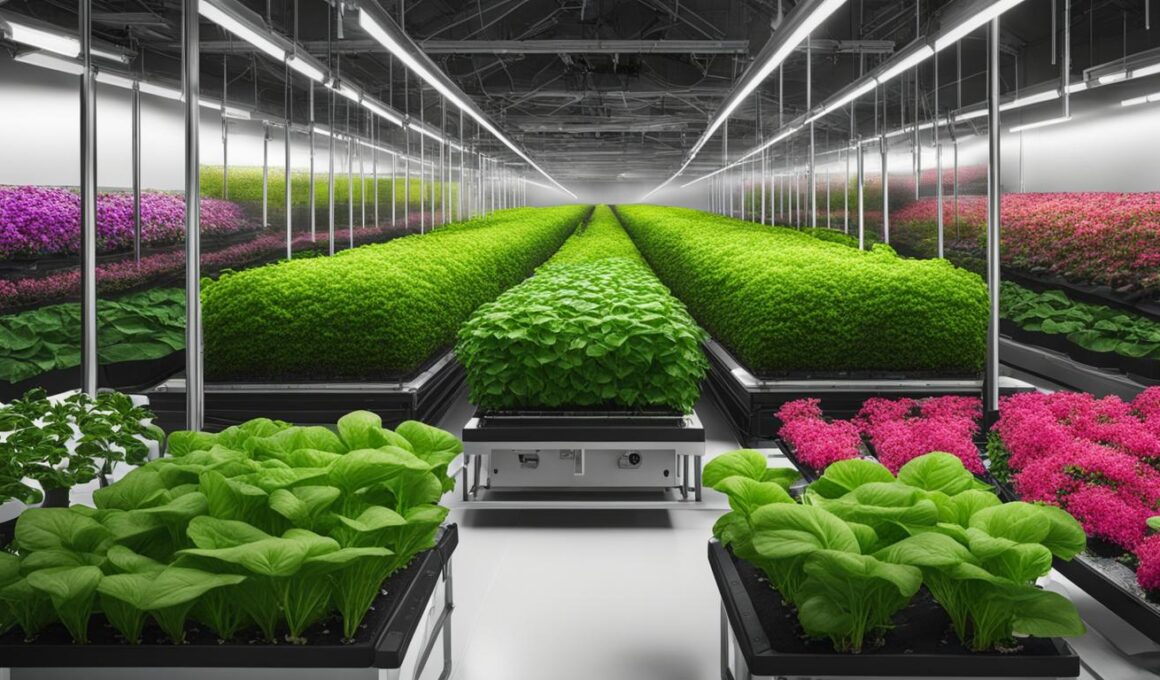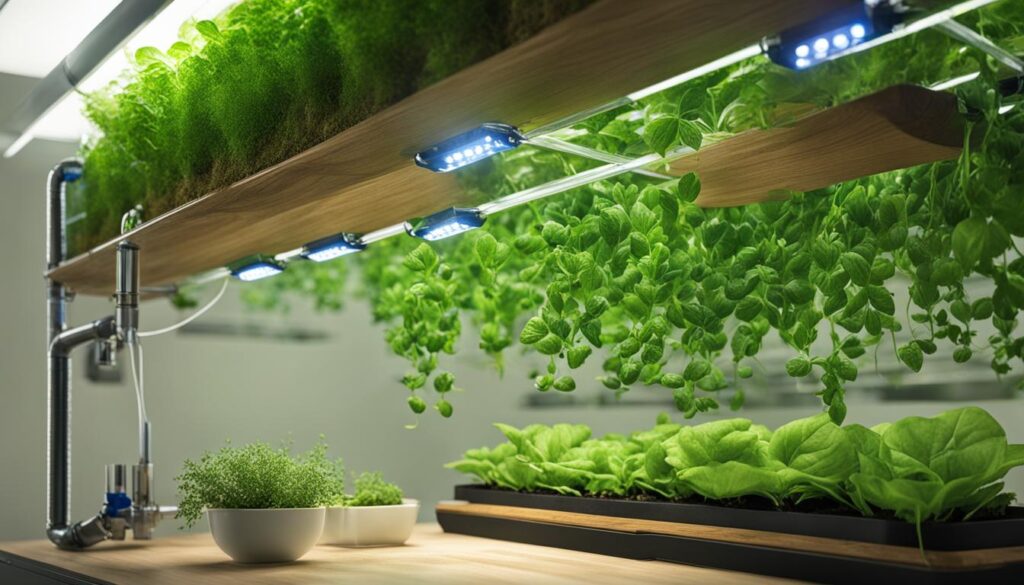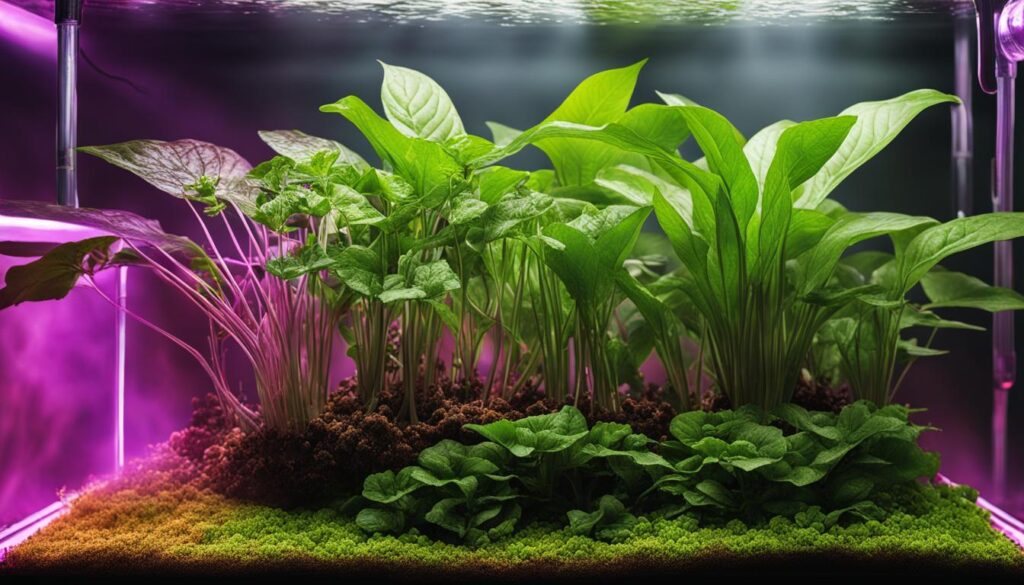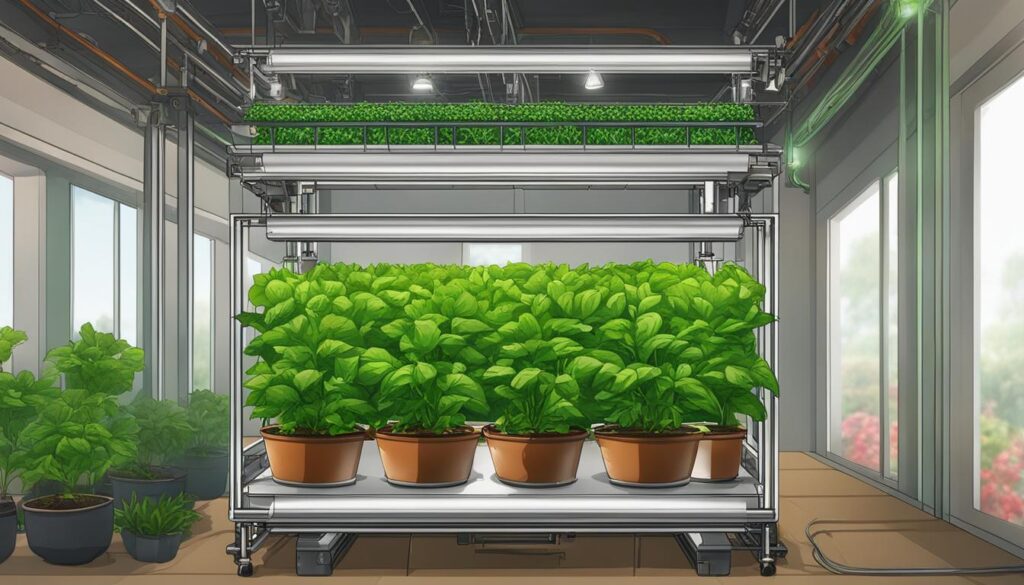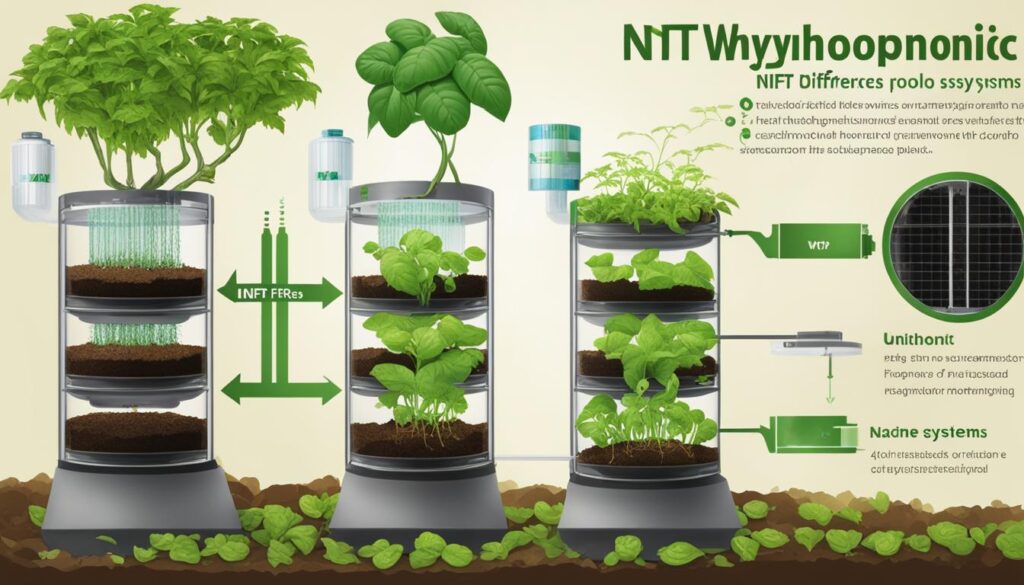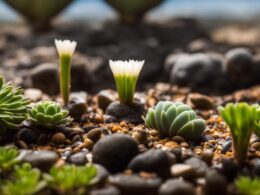Interested in hydroponic gardening? Two popular methods you should know about are NFT (Nutrient Film Technique) and DWC (Deep Water Culture). While both techniques allow you to grow plants without soil, they have distinct differences that can impact your gardening experience. Let’s dive in and explore the variances between NFT and DWC hydroponics, including their systems, benefits, drawbacks, and suitability for different types of growers.
Post Summary
- NFT and DWC are two popular hydroponic methods for growing plants without soil.
- DWC involves placing plants on floating rafts with roots submerged in a nutrient solution.
- NFT uses a sloped trough or tube to circulate a shallow nutrient solution that flows by the roots.
- DWC offers better temperature stability and is beginner-friendly, while NFT saves water and allows for easy examination of roots.
- Consider factors such as crop type, experience level, and specific requirements when choosing between NFT and DWC hydroponics.
What is Deep Water Culture (DWC)?
Deep Water Culture, also known as DWC, is a popular hydroponic system that involves floating rafts and a nutrient solution. In this system, plants are placed on floating rafts with their roots submerged in the nutrient solution, ensuring constant access to water and nutrients.
The DWC system can be either passive or active. In a passive DWC system, the nutrient solution is continuously flowing, while in an active DWC system, the solution is recirculated. This hydroponic method is considered user-friendly, making it an ideal choice for first-time hydroponic growers.
DWC offers several advantages over other hydroponic systems. Firstly, it provides better temperature stability as the roots are constantly immersed in water. This stability helps promote optimal plant growth. Secondly, DWC systems are relatively easy to clean and maintain, making them a convenient option for growers.
However, it’s important to note that managing waste water and preventing water-borne diseases require additional attention in DWC systems. Regular monitoring and maintenance ensure the health and vitality of the plants. Overall, DWC is a reliable and efficient hydroponic system, especially for beginner growers.
| Advantages of Deep Water Culture (DWC) | Disadvantages of Deep Water Culture (DWC) |
|---|---|
| Constant access to water and nutrients | Requires additional attention to manage waste water and prevent water-borne diseases |
| Provides better temperature stability for optimal plant growth | Challenging for longer growing periods |
| Easy to clean and maintain | Requires effort to check and refill each bucket |
| User-friendly system, ideal for beginners |
What is Deep Water Culture (DWC)?
“DWC is a reliable and efficient hydroponic system, especially for beginner growers.”
What is Nutrient Film Technique (NFT)?
Nutrient Film Technique, also known as NFT, is a hydroponic system that utilizes a shallow nutrient solution to nourish plant roots. In an NFT system, plants are placed in gutters or tubes with a slight slope, allowing a thin film of nutrient solution to flow past the roots. This constant flow of nutrients ensures that plants receive a continuous supply of water and essential nutrients. Unlike Deep Water Culture (DWC) systems, NFT systems use a low volume of water, which can result in temperature fluctuations and challenges in distributing nutrients evenly.
To set up an NFT system, you will need gutters or tubes with a gentle slope, a pump to circulate the nutrient solution, and a reservoir to store the solution. The roots of the plants are suspended in the gutters, allowing them to absorb the nutrient-rich film. One of the advantages of NFT systems is the ease of examining the roots of the plants, as they are exposed and visible. This visibility makes it easier to identify and address any root-related issues.
However, NFT systems require closer monitoring compared to DWC systems. The low volume of water in NFT systems means that any imbalance or interruption in the flow of nutrients can have a significant impact on plant health. Additionally, the shallow nutrient film can be prone to drying out if the system experiences a power outage or pump failure. Proper monitoring and adjustments are necessary to maintain optimal nutrient flow and prevent any adverse effects on plant growth.
In summary, Nutrient Film Technique (NFT) is a hydroponic system that uses a shallow nutrient film to nourish plant roots. While NFT systems offer benefits such as water savings and easy examination of roots, they require closer monitoring and may not be ideal for beginners. Consider factors such as your level of experience and ability to closely manage nutrient flow when deciding whether NFT is the right hydroponic system for you.
Benefits of Deep Water Culture Hydroponics vs. NFT
When considering the benefits of Deep Water Culture (DWC) hydroponics compared to Nutrient Film Technique (NFT), there are several factors to take into account. DWC hydroponics offers distinct advantages in terms of reliability, temperature and nutrient stability, and ease of cleaning.
DWC systems are highly resilient during power outages because the plant roots are constantly submerged in the nutrient solution. This ensures that the plants continue to receive the necessary nutrients even without electricity. Additionally, the larger volume of water in DWC systems provides better temperature stability, preventing drastic fluctuations that can negatively impact plant growth.
Cleaning a DWC system is generally easier compared to an NFT system. With DWC, you can simply drain and refill the system, minimizing the risk of clogs or nutrient build-up. This ease of maintenance can save time and effort for growers.
“DWC hydroponics provides reliable nutrient delivery and temperature stability, making it suitable for growers in areas prone to power outages or temperature fluctuations.”
Comparison of Benefits:
| DWC Hydroponics | NFT Hydroponics |
|---|---|
| Reliable during power outages | Water-saving |
| Temperature stability | Suitable for lettuce and space-constrained environments |
| Easy cleaning | Easy examination of roots |
While DWC hydroponics offers these benefits, it’s important to note that NFT hydroponics has its own advantages. NFT systems save water compared to DWC systems, making them more environmentally friendly. Additionally, NFT systems are particularly suitable for lettuce and other leafy greens, making them a popular choice among growers focused on these crops. The design of NFT systems also allows for easy examination of roots, which can be beneficial for monitoring plant health.
Ultimately, choosing between DWC and NFT hydroponics depends on the specific needs and preferences of the grower. Each system has its own unique benefits and considerations. Regular maintenance and attention to detail are essential for optimal plant health and yield, regardless of the chosen hydroponic system.
Material Needed for NFT and DWC Systems
When setting up a hydroponic system, it’s important to have all the necessary materials in order to ensure optimal plant growth. The materials required for NFT (Nutrient Film Technique) and DWC (Deep Water Culture) systems differ slightly, reflecting the unique designs and functionalities of each system.
For an NFT system, you will need the following materials:
- Reservoir
- Water pump
- Gutter or trough
- Net pots
- Nutrient solution
- Timer
On the other hand, a DWC system requires the following materials:
- Reservoir
- Air pump
- Air stone
- Growing medium
- Net pots
- Nutrient solution
These materials are essential for the proper functioning of NFT and DWC systems, ensuring that plants receive the necessary nutrients and oxygen for healthy growth. It’s important to note that the choice of materials may vary depending on the specific setup and scale of your hydroponic operation.
| Materials | NFT System | DWC System |
|---|---|---|
| Reservoir | Required | Required |
| Air Pump | Not required | Required |
| Air Stone | Not required | Required |
| Gutter/Trough | Required | Not required |
| Water Pump | Required | Not required |
| Growing Medium | Not required | Required |
| Net Pots | Required | Required |
| Timer | Required | Not required |
| Nutrient Solution | Required | Required |
By having a thorough understanding of the materials needed for NFT and DWC systems, you can ensure that you have everything required to set up and maintain a successful hydroponic garden.
Pros and Cons of NFT and DWC Systems
When considering hydroponic systems, it’s important to weigh the pros and cons of each option. Both NFT (Nutrient Film Technique) and DWC (Deep Water Culture) systems have their advantages and disadvantages. Here’s a breakdown of what you need to know:
Advantages of NFT Systems:
- Water Savings: NFT systems use a thin film of nutrient solution, resulting in less water usage compared to DWC systems.
- Low Maintenance: NFT systems require minimal maintenance, making them an attractive option for growers looking for a hassle-free setup.
- Root Examination: The design of NFT systems allows for easy examination of plant roots, making it convenient to monitor their health and progress.
Disadvantages of NFT Systems:
- Not Beginner-Friendly: NFT systems require closer monitoring and attention, making them less suitable for new hydroponic growers.
- Pump Sensitivity: NFT systems heavily depend on the functionality of the nutrient solution pump, and any failure can disrupt the nutrient flow to the plants.
- Not Suitable for Larger Plants: NFT systems may not be ideal for crops with extensive root systems or larger plants that require more space for growth.
Advantages of DWC Systems:
- Beginner-Friendly: DWC systems are often recommended for new growers due to their ease of use and forgiving nature.
- Suitable for Larger Plants: DWC systems provide ample space for larger plants with extensive root systems to grow and thrive.
- Water Temperature Control: With roots constantly immersed in water, DWC systems offer better control over water temperature and stability.
Disadvantages of DWC Systems:
- Root Management: Proper management of plant roots, including preventing root rot and ensuring adequate oxygenation, is crucial in DWC systems.
- Challenging for Longer Growing Periods: DWC systems can become more challenging to maintain over extended growing periods, requiring consistent attention and adjustments.
- Bucket Refilling: DWC systems typically consist of individual buckets, which need to be checked and refilled regularly to maintain the correct nutrient levels.
As you can see, NFT and DWC systems both have their unique advantages and disadvantages. When choosing between the two, consider factors such as your experience level, the specific needs of your crops, and your ability to manage and maintain the system. Remember, regular maintenance and attention to detail are essential for the success of any hydroponic setup.
DWC vs. NFT Hydroponic: Which One to Choose?
When deciding between DWC hydroponics and NFT hydroponics, it’s important to consider various factors to ensure you choose the system that best suits your needs. Both methods have their own strengths and weaknesses, so let’s take a closer look at the comparison to help you make an informed decision.
DWC Hydroponics
Deep Water Culture (DWC) hydroponics is an ideal choice for beginners and those looking for a forgiving system. The constant immersion of plant roots in the nutrient solution provides excellent temperature and nutrient stability. DWC systems are also more reliable during power outages, making them a suitable option for growers in areas with frequent power interruptions. Additionally, cleaning a DWC system is relatively easy compared to other methods.
NFT Hydroponics
Nutrient Film Technique (NFT) hydroponics, on the other hand, offers benefits such as water savings and easy access to root examination. The shallow nutrient solution used in NFT systems allows for efficient nutrient uptake by the plants. However, NFT systems may not be as beginner-friendly as DWC systems, requiring closer monitoring and management. They are also more sensitive to pump failure and may not support larger plants with extensive root systems.
| DWC Hydroponics | NFT Hydroponics | |
|---|---|---|
| Reliability | More resilient during power outages | |
| Temperature and Nutrient Stability | Excellent stability due to larger water volume | |
| Cleaning | Relatively easy compared to other systems | |
| Water Savings | Significant water savings | |
| Root Examination | Easy access to roots for examination |
Ultimately, the choice between DWC and NFT hydroponics depends on your specific requirements, experience level, and the type of crops you intend to grow. If you’re new to hydroponics or prefer a more forgiving system, DWC may be the better option. On the other hand, if you have experience and want to maximize efficiency, NFT could be the right choice. Consider factors such as reliability, temperature and nutrient stability, cleaning requirements, water-borne disease management, and oxygenation when selecting the most suitable hydroponic system for your needs.
Other Hydroponic Systems to Consider
While NFT and DWC hydroponic systems are popular choices, there are other options worth considering for your hydroponic setup. One such system is the ebb and flow, also known as flood and drain. This method involves alternating flooding and draining the nutrient solution, creating a cyclical watering pattern for the plants. Ebb and flow systems are known for their ability to cultivate root vegetables and offer high oxygenation rates.
However, it’s important to note that ebb and flow systems come with their own set of considerations. These systems require more pump power and frequent flushing to maintain optimal nutrient levels. Additionally, sludge removal and adjustments to accommodate plant age may be necessary. Due to their complexity, ebb and flow systems may not be the best choice for new growers.
When deciding on a hydroponic system, carefully weigh the benefits and drawbacks of each option. Consider factors such as your experience level, the specific crops you plan to grow, and your available resources. The table below provides a summary of the key differences between NFT, DWC, and ebb and flow systems to help inform your decision-making process.
| Hydroponic System | Benefits | Drawbacks |
|---|---|---|
| NFT |
|
|
| DWC |
|
|
| Ebb and Flow |
|
|
Conclusion
In summary, NFT and DWC hydroponic systems have distinct differences in terms of design, functionality, and suitability for different growers. DWC systems are recommended for beginners due to their forgiving nature, better temperature stability, and reliability during power outages. On the other hand, NFT systems are water-saving, suitable for specific crops, and provide easy access to root examination.
When deciding between NFT and DWC hydroponics, it is important to consider your specific needs, experience level, and crop requirements. If you are new to hydroponics or prefer a more user-friendly system, DWC is a great choice. For experienced growers looking to fine-tune their setups and maximize efficiency, NFT systems offer unique advantages.
Remember, regardless of the system you choose, regular maintenance and attention to detail are crucial for optimal plant health and yield in any hydroponic setup. By carefully considering the differences between NFT and DWC systems and understanding how they align with your goals and preferences, you can make an informed decision to create a successful hydroponic garden.
What Are the Advantages of NFT Hydroponics Compared to Other Types?
NFT hydroponics offer several advantages over other types of hydroponics. The nutrient film technique facilitates efficient water and nutrient use, leading to faster growth and higher yields. Additionally, NFT systems require less space and are ideal for growing leafy greens and herbs.
FAQ
What is the difference between NFT and DWC hydroponics?
NFT and DWC hydroponics differ in their systems, with NFT using a shallow nutrient solution flowing by the roots and DWC submerging the roots in a nutrient solution. They also have different benefits and drawbacks.
What is Deep Water Culture (DWC)?
Deep Water Culture is a hydroponic system where plants are placed on floating rafts with their roots submerged in a nutrient solution. It is considered user-friendly and offers better temperature stability.
What is Nutrient Film Technique (NFT)?
Nutrient Film Technique is a hydroponic system where plants sit in gutters with a shallow nutrient solution flowing by their roots. It relies on a thin film of nutrient solution and offers benefits such as water savings and easy examination of roots.
What are the benefits of Deep Water Culture (DWC) hydroponics compared to NFT?
DWC hydroponics offer better temperature stability, are more suitable for beginners, and are reliable during power outages. They also provide an easy cleaning process. However, DWC requires additional attention for waste water management and preventing water-borne diseases.
What materials are needed for NFT and DWC hydroponic systems?
For an NFT system, you will need a reservoir, air pump, air stone, plant channel, distilled water, water pump, net pots, timer, and nutrient solution. A DWC system requires a reservoir, air pump, air stone, distilled water, growing medium, nutrient solution, and net pots.
What are the pros and cons of NFT and DWC hydroponic systems?
NFT systems save water, are suitable for certain crops, and provide easy access to root examination. However, they may not be beginner-friendly and are sensitive to pump failure. DWC systems are beginner-friendly, suitable for larger plants, offer better water temperature control, and are more stable during power outages. However, they require proper management of plant roots and can be challenging for longer growing periods.
Which hydroponic system should I choose between DWC and NFT?
The choice between DWC and NFT hydroponic systems depends on factors such as the type of crops you want to grow, your experience level, and specific requirements. DWC systems are recommended for new growers and those seeking a more forgiving system, while NFT systems are suitable for experienced growers looking to maximize efficiency.
What are other hydroponic systems worth considering?
Apart from NFT and DWC, other hydroponic systems worth considering include ebb and flow, also known as flood and drain. These systems offer benefits like root vegetable cultivation and high oxygenation rates but may require more maintenance and adjustments.





